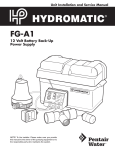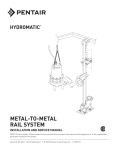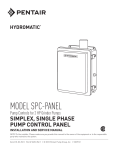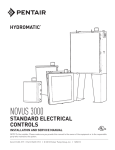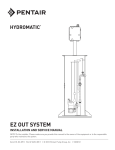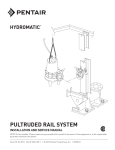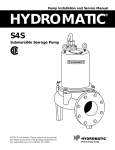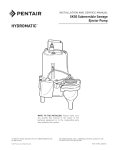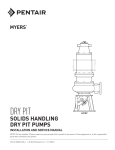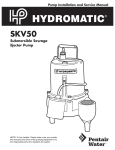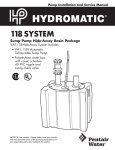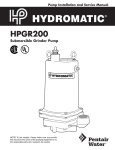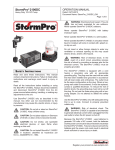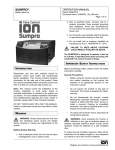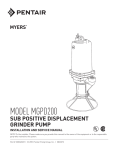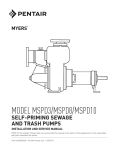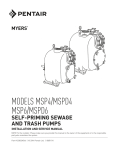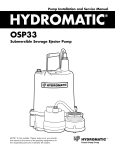Download relay logic control panels installation and service manual
Transcript
RELAY LOGIC CONTROL PANELS INSTALLATION AND SERVICE MANUAL NOTE! To the installer: Please make sure you provide this manual to the owner of the equipment or to the responsible party who maintains the system. Item # H-03-481 | Part # 5625-481-1 | © 2014 Pentair Ltd. | 12/11/14 General Information This manual contains important information for the safe use of this product. Read this manual completely before using this product and refer to it often for continued safe product use. Do not throw away or lose this manual. Reasonable care and safe methods should be practiced. Check local codes and requirements before installation. Unpacking Panel: When unpacking unit, check for concealed damage. Claims for damage must be made at the receiving end through the delivery carrier. Damage cannot be processed from the factory. CALIFORNIA PROPOSITION 65 WARNING: This product and related accessories contain chemicals known to the State of California to cause cancer, birth defects or other reproductive harm. Power Supply WARNING: Do not attempt to wire this control box unless you have a good working knowledge of electricity and are familiar with the state and local codes. If you are in doubt about anything, contact a qualified electrician. Do not attempt to operate this unit on any other voltage or power distribution other than for which it was originally designed (check nameplate). Failure to comply with this will result in the immediate cancellation of all warranties and claims. It is advisable to put the panel on its own circuit using a circuit breaker adequately sized to protect the pump(s). Check state 2 and local codes for the correct wire size and circuit protection to use. The wire should be sized large enough to handle the full load current of the pump(s) you are operating, and any voltage drop that might occur due to long service runs. Run power supply lines to the control box and secure. Select a convenient location on the bottom to enter the box with the power supply. Cut a hole with a chassis punch. Avoid getting metal chips in the components while cutting hole. After the hole is cut, any metal particles must be removed from the box. Failure to do so may result in premature component failure. Connect incoming power to the terminal blocks labeled L1, L2, L3 and all necessary ground wires to the ground lug at the bottom of the box. The ground lug should be fastened to a good driven earth ground by one of the methods described in the National Electric Code. NEC does not permit using ground as a current carrying conductor, therefore a neutral must be provided for 115 volt 1-phase, 208 volt 1-phase, 230 volt 1-phase or 208 volt 3-phase systems. WARNING: Before handling these pumps and controls, always disconnect the power first. Do not smoke or use sparkable electrical devices or flames in a septic (gaseous) or possible septic sump. Electrical Connections: The contractor must conform to the latest requirements of the National Electrical Code. All conduit and cables shall be in accordance with NEC Code NFPA #70. To maintain UL and CSA ENCL rating, use the same type UL and CSA weatherproof conduit hubs when connecting to this enclosure. Prior to conducting any installation, repair or service with regard to the control panel, refer to the schematic appropriate for that panel. The schematic will provide guidance with regard to the terminal block connections. CAUTION: A nonmetallic enclosure does not provide grounding conduit connections. Use grounding bushing and jumper wires. Make the Following Electrical Connections: a. Connect the pump leads to the control panel. If pump is single-phase and the panel has start capacitor, start relay and run capacitor, it is critical that the pump leads be connected properly. The White, Black and Red pump leads must be connected to the appropriate terminals as directed by the panel schematic and the label on the back panel below the terminals. b. Connect the pump heat sensor and seal failure leads (if available on the pump) to the appropriate terminal blocks in the control panel. c. Connect all the float control leads or 4-20mA leads to the appropriate panel terminals. Contractor must be very careful in locating the floats at the proper elevations. The maximum distance from the control panel to the floats is the lesser of l00 feet, or the maximum distance recommended for the pump. d. Before connecting power to the control panel, make sure all control switches (e.g. H-O-A switch) and protective devices (e.g. breakers) are in the Off position. Now connect power to the terminal block or the circuit breaker as directed by the schematic. e. Control panel must be grounded properly per NEC and/or local codes. To facilitate this, a ground lug is provided on the control panel. Start-Up Operation 1. Check junction box for moisture. Moisture may cause chattering of relays/ contactors. 2. If pump is single-phase with start capacitor, start relay and run capacitor in panel. Check that pump White, Black and Red power wires are connected to panel correctly. 3. Check incoming power voltage to make sure that it is correct for panel and pump model. 4. Turn on power to panel. 5. Check overload relay and verify reset mode (if overload is supplied). 6. Check voltage to the panel and at secondary of control transformer using a voltmeter. If no transformer is supplied, check voltage at the circuit breakers. 7. With H-O-A switch in hand, check discharge to verify the pump is running. Check for flow. On three-phase power, check to see if each pump has proper rotation. Wrong rotation will give low flow. 8. Check full load current with amp probe and compare it with the nameplate rating. On three-phase pumps, check all three phases. On singlephase pumps, check black pump lead. 9. Check operation of start relay, if supplied on singlephase panels. 10.With H-O-A switch in Auto, check float operation and response to control panel to the float operation. For sequence of operation, refer to design specification. 11.Make sure H-O-A switch is left in the Auto position after start-up is completed. Pump Start-Up: Refer to pump Installation and Service Manual. Pump Maintenance The maintenance schedule will vary with operating and environmental conditions. It will also vary with the specific type of control supplied. 1. Exercise breaker through one cycle. Be careful not to overexercise as the breaker is not a switching device. Excessive operations tend to affect the trip curve of the breaker. 2. Check contactors and relays for excessive humming. This can be accomplished by turning pumps on and off in the Hand mode with the H-O-A switch. 3. Check pump run light(s) by running pump(s) in Hand mode. Check bulb(s) in any other light(s). 4. With the power off, check continuity of all control fuses. 5. Check voltage at primary and secondary of control transformer. 6. Check the pump fullload amps. 7. For single-phase panels with start circuit, about 5 seconds after the pump starts check the voltage from terminal 1 to terminal 2 on the start relay to be sure that the relay has operated. The voltage from terminal 1 to terminal 2 on the start relay must exceed 10 VAC. For some pumps the voltage may exceed 400 VAC. If after 5 seconds the voltage from terminal 1 to terminal 2 on the start relay does not exceed 10 VAC stop the pump as damage to the start capacitor may occur in about 15 seconds. If the start relay is not operating check the pump and the system voltage to be sure that they match. Check the power wiring to ensure that the pump is connected properly. Start the pump once more and check that the voltage from the terminal for the black wire to the white wire is within system tolerance. 8. Check junction boxes for moisture. Moisture may cause chattering of relays and contactors. 9. Check for moisture inside control panel enclosure. Moisture can cause damage to electrical components. Check door gasket for proper seal. 10.Check labels to verify they have not been damaged. 11.Lubricate enclosure hinges. 12.Pull floats and check for proper operation and ensure there is no foreign buildup on them. Spare Parts List: The following is a list of recommended spare parts. However, conditions of service vary significantly and a general list may not in its entirety be 3 applicable to a given installation. The user should exercise judgment in defining specific requirements based on this guide. 1. Fuses for control transformer primary and secondary. (If required) 2.Contactor. 3. Bulbs for any light requiring a bulb. 4. Control transformer. (If required) 5. Alternator relay. (If required) Float Controls Optional: The low water/ redundant off float should be installed just above where the pump begins to ingest air normally; this is about the top of the volute. The off float should be installed about halfway down the pump. If a low water/redundant off float is used, then the off float should be installed a minimum of 4 inches above the low water/redundant off float. Install the on/lead floats a minimum of 4 inches above the off float. If additional volume is to be pumped on each cycle or if the pump running time for each cycle needs to be increased, then increase the distance from the on/lead float to the off float as needed. Install the high water float 4 inches above the on/lead float. For duplex systems install the lag/override float 4 inches above the high water float. On duplex systems where both pumps have to run on a daily basis to keep up with the incoming flow, then the high water and the lag/override float position should be reversed. 4 Troubleshooting 1. Pump does not run in Hand position. a. Check pump circuit breaker and control fuse for tripping or blown condition. b. Check incoming power voltage and control circuit voltage. c. Check overload relay to see if it is tripped. Reset relay if tripped and check pump current with amp meter. d. With the power off, check motor heat sensor continuity. e. Check wiring of pump to control panel. It should agree with the schematic. f. Check contactor coil resistance. 2. Pump does not run in Auto position. a. Check items above in #1. b. Floats may be miswired to control panel. Check float type (N.O. or N.C.) and hook up by referring to the schematic. If the start and stop floats are hooked in reverse, pump will short cycle and will not pump the level down. 1.Check if the water level in the system is high enough to activate the floats. 2.If there is enough water in the system (with the power turned off), mark and disconnect the off and on floats. Next, install jumper wires in the terminal blocks for off and on floats. Turn power back on, put H-O-A switch in Auto and see if pump runs. 3.If pump runs with jumper, problem is with floats. Remove jumpers and troubleshoot floats with ohmmeter. 4.If pump does not run in Auto mode with jumpers, check Auto circuit wiring in panel. 3. Pump runs, but run light does not energize. a.Remove light and check with an ohmmeter. b.Check run light wiring. 4. Pump runs but does not pump down the wet well. a.On three-phase only, pump rotation may be wrong. Wiring of pump to control panel may be reverse sequenced. b.Impeller may be dragging in volute due to solids. High amperage draw would identify this. c.Refer to the pump manual for other possibilities. 5. Severe humming/ chattering of contactors and control relays. a.There may be low voltage. Check voltage at primary and secondary of control transformer using a voltmeter. This low voltage condition may cause severe chattering and burnout of contactors and relays. b.Contactor may have dust around magnet of coil structure. Dry or clean as required. c.Check voltage to the control panel. Contactors require a minimum of 85% of full voltage to pull in without chatter. If the problem is a recurring one, measure voltage with recorder on a 24 hour basis. d.Make sure the floats are located away from any turbulence. e.Dry out the junction box (if furnished); moisture in the junction box may cause relays to energize intermittently. 6. Short cycling pump. a.Check float controls. 7. Run light stays on. a.Selector switch may be in the Hand position. 8. Nuisance tripping of overload on motor starters or circuit breakers. a.Check pump amp draw with amp probe and compare to nameplate amps on pump. b.The impeller may be locked up due to excessive debris or solids. c.Possible motor failure (fault in windings). d.Pump may be miswired to terminal block. e.Check for possible voltage and current unbalance. (Three-phase only). Voltage unbalance on three-phase power sources can cause motor current to become unbalanced and excessive heating will result. Tripping of the overload protectors and premature motor failures can be expected if the current unbalance exceeds five percent. Percent Current = Unbalance Maximum Current Difference from x 100 Average Current Average Current To determine if motor current unbalance is a function of the motor or the power supply: 1.Label the leads and the terminals 1, 2 and 3 respectively. 2.Record the amperage for each lead. 3.Move each lead to the next terminal (1 to 2, 2 to 3, 3 to 1). 4.Read the amperage of each lead. 5.Move each lead to the next terminal (1 to 3, 2 to 1, 3 to 2). 6.Read the amperage of each lead. 7.If the unbalance moves with the motor leads, the unbalance is caused by the motor. If the unbalance remains with the terminals, the unbalance is in the power supply. 8.If the current unbalance exceeds five percent, nuisance tripping or excessive heating will result. 9.Connect leads for the lowest percent of current unbalance. f.Check connections and start components on singlephase units. 1.Disconnect all power from the panel before making these checks. 2.Motor winding resistance readings. a. Disconnect all three motor leads from panel terminal blocks. b. Using a volt-ohmmeter, with the scale set on RX1, measure the resistance between the leads with the chart. Typical Resistance Winding Motor Leads Reading Main Start Both Black to White Black to Red White to Red Lowest Next Lowest (Middle) Highest (Main & Start) 3. Check capacitor. a. Make sure the capacitor is discharged. Use extreme caution as a spark might occur. b.Disconnect the capacitor leads and connect an analog-type volt-ohmmeter to the capacitor terminals. c. Set the meter on the RX1,000 scale to check the start capacitor. Set the meter on the RX10,000 scale to check the run capacitor. d. The meter should indicate low ohms when it is first connected, but as the capacitor becomes charged (by the meter), it will return to a reading of infinity (open circuit). 4. Check start relay. a. Check the coil resistance. It should be 3,000 to 15,000 ohms. b. Install a clamp on amp meter around the start winding lead. c. Set the amp meter scale to at least 2 times the pump motor full load current. d. Place the H-O-A switch in the Hand position to start the pump. e. The meter should read approximately 2 times full load current during starting. 5 f. After the motor has started (within one second) the current should drop to a value much less than full load current. 5. Motor voltage check: Component Main Winding Main Winding Start Winding Start Winding 6 Typical Motor Lead Mode Black to White Start Black to White Run Black to Red Start Black to Red Run Voltage Reading Line Voltage Line Voltage Line Voltage 120% Line Voltage THIS PAGE INTENTIONALLY LEFT BLANK STANDARD LIMITED WARRANTY Pentair Hydromatic® warrants its products against defects in material and workmanship for a period of 12 months from the date of shipment from Pentair Hydromatic or 18 months from the manufacturing date, whichever occurs first – provided that such products are used in compliance with the requirements of the Pentair Hydromatic catalog and technical manuals for use in pumping raw sewage, municipal wastewater or similar, abrasive-free, noncorrosive liquids. during the warranty period and subject to the conditions set forth, Pentair Hydromatic, at its discretion, will repair or replace to the original user, the parts that prove defective in materials and workmanship. Pentair Hydromatic reserves the right to change or improve its products or any portions thereof without being obligated to provide such a change or improvement for prior sold and/or shipped units. Start-up reports and electrical schematics may be required to support warranty claims. Submit at the time of start up through the Pentair Hydromatic website: http://forms.pentairliterature.com/startupform/startupform.asp?type=h. Warranty is effective only if Pentair Hydromatic authorized control panels are used. All seal fail and heat sensing devices must be hooked up, functional and monitored or this warranty will be void. Pentair Hydromatic will cover only the lower seal and labor thereof for all dual seal pumps. under no circumstance will Pentair Hydromatic be responsible for the cost of field labor, travel expenses, rented equipment, removal/reinstallation costs or freight expenses to and from the factory or an authorized Pentair Hydromatic service facility. This limited warranty will not apply: (a) to defects or malfunctions resulting from failure to properly install, operate or maintain the unit in accordance with the printed instructions provided; (b) to failures resulting from abuse, accident or negligence; (c) to normal maintenance services and parts used in connection with such service; (d) to units that are not installed in accordance with applicable local codes, ordinances and good trade practices; (e) if the unit is moved from its original installation location; (f) if unit is used for purposes other than for what it is designed and manufactured; (g) to any unit that has been repaired or altered by anyone other than Pentair Hydromatic or an authorized Pentair Hydromatic service provider; (h) to any unit that has been repaired using non factory specified/ oEM parts. Warranty Exclusions: PEnTAiR HYdRoMATiC MAKES no EXPRESS oR iMPLiEd WARRAnTiES THAT EXTEnd bEYond THE dESCRiPTion on THE FACE HEREoF. PEnTAiR HYdRoMATiC SPECiFiCALLY diSCLAiMS THE iMPLiEd WARRAnTiES oF MERCHAnTAbiLiTY And FiTnESS FoR AnY PARTiCuLAR PuRPoSE. Liability Limitation: in no EVEnT SHALL PEnTAiR HYdRoMATiC bE LiAbLE oR RESPonSibLE FoR ConSEQuEnTiAL, inCidEnTAL oR SPECiAL dAMAGES RESuLTinG FRoM oR RELATEd in AnY MAnnER To AnY PEnTAiR HYdRoMATiC PRoduCT oR PARTS THEREoF. PERSonAL inJuRY And/oR PRoPERTY dAMAGE MAY RESuLT FRoM iMPRoPER inSTALLATion. PEnTAiR HYdRoMATiC diSCLAiMS ALL LiAbiLiTY, inCLudinG LiAbiLiTY undER THiS WARRAnTY, FoR iMPRoPER inSTALLATion. PEnTAiR HYdRoMATiC RECoMMEndS inSTALLATion bY PRoFESSionALS. Some states do not permit some or all of the above warranty limitations or the exclusion or limitation of incidental or consequential damages and therefore such limitations may not apply to you. no warranties or representations at any time made by any representatives of Pentair Hydromatic shall vary or expand the provision hereof. 740 EAST 9TH STREET ASHLAnd, oHio, uSA 44805 419-289-1144 WWW.HYdRoMATiC.CoM Warranty Rev. 12/13 490 PinEbuSH RoAd, uniT #4 CAMbRidGE, onTARio, CAnAdA n1T 0A5 800-363-PuMP








